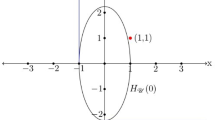Abstract
A variety of problems in computer science, operations research, control theory, etc., can be modeled as non-linear and non-differentiable max–min systems. This paper introduces the global optimization into such systems. The criteria for the existence and uniqueness of the globally optimal solutions are established using the high matrix, optimal max-only projection set and k s-control vector of max–min functions. It is also shown that the global optimization can be accomplished through the partial max-only projection representation with algebraic and combinatorial features. The methods are constructive and lead to an algorithm of finding all globally optimal solutions.
Similar content being viewed by others
References
Andramonov M.Y., Rubinov A.M. and Glover B.M. (1999). Cutting angle method in global optimization. Appl. Math. Lett. 12(3): 95–100
Baccelli F., Cohen G., Olsder G.J. and Quadrat J.-P. (1992). Synchronization and Linearity Wiley Series in Probability and Mathematical Statistics. Wiley, New York
Baccelli F. and Mairesse J. (1998). Ergodic theorem for stochastic operators and discrete event networks. In: Gunawardena, J. (ed) Idempotency. Cambridge University Press, Cambridge
Bagirov A.M. and Rubinov A.M. (2003). Cutting angle method and a local search. J. Glob. Optim. 27(2, 3): 193–213
Batten L. and Beliakov G. (2002). Fast algorithm for the cutting angle method of global optimization. J. Glob. Optim. 24(2): 149–161
Beaumont F. (1990). Algorithm for disjunctive programming problems. Eur. J. Oper. Res. 48: 362–371
Cassandras C.G. and Lafortune S. (1999). Introduction to Discrete Event Systems. Kluwer Academic Publishers, Boston
Chakraborty S., Yun K.Y. and Dill D.L. (1999). Timing analysis of asynchronous systems using time separation of events. IEEE Trans. Comput. Aided Des. Integr. Circuits Syst. 18: 1061–1076
Cochet-Terransson J., Gaubert S. and Gunawardena J. (1999). A constructive fixed point theorem for min-max functions. Dyn. Stability Syst. 14(4): 407–433
Cohen G., Moller P., Quadrat J.-P., Viot M.: Linear system theory for discrete event systems. In: Proceedings of the 23-rd Conference on Decision and Control, pp.539–544 (1984)
Cohen G., Moller P., Quadrat J.-P. and Viot M. (1989). Algebraic tools for the performance evaluation of discrete event systems. Proc. IEEE 77(1): 39–58
Cuninghame-Green R.A. (1979). Minimax Algebra. Volume 166 of Lecture Notes in Economics and Mathematical Systems. Springer, Berlin Heidelberg New York
De Schutter B. and De Moor B. (1995a). Minimal realization in the max algebra is an extended linear complementarity problem. Syst. Control Lett. 25(2): 103–111
De Schutter B. and De Moor B. (1995b). The extended linear complementarity problem. Math.~Program. 71(3): 289–325
De Schutter B., Heemels W.P.M.H. and Bemporad A. (2002). On the equivalence of linear complementarity problems. Oper. Res. Lett. 30(4): 211–222
Du D. and Pardalos P.M. (eds) (1995). Minimax and Applications. Kluwer Academic Publishers, Dordrecht
Du D., Pardalos P.M. and Wu W. (2001). Mathematical Theory of Optimization. Kluwer Academic Publishers, Dordrecht
Gaubert S., Butkovic P. and Cuninghame-Green R.A. (1998). Minimal (max,+) realization of convex sequences. SIAM J. Control Optim. 36: 137–147
Gaubert S. and Gunawardena J. (1998a). The duality theorem for min-max functions. C. R. Acad. Sci. 326: 43–48
Gaubert, S., Gunawardena, J.: A non-linear hierarchy for discrete event systems. In: Proceedings of the Fourth Workshop on Discrete Event Systems, Cagliari, Italy (1998b)
Grossmann I.E. and Lee S. (2003). Generalized disjunctive programming: non-linear convex hull relaxation and algorithms. Comput. Optim. Appl. 26: 83–100
Gunawardena, J.: Periodic behaviour in timed systems with causality. Part I: systems of dimension 1 and 2, Technical Report STAN-CS-93-1462, Department of Computer Science, Stanford University (1993a)
Gunawardena, J.: Timing analysis of digital circuits and the theory of min-max functions. In: Proceedings of the TAU 93, ACM International Workshop on Timing Lssues in the Specification and Synthesis of Digital Systems (1993b)
Gunawardena J. (1994a). Min-max functions. Discrete Event Dyn. Syst. 4(3): 377–406
Gunawardena, J.: Cycle times and fixed points of min-max functions. In: Proceedings of the 11th International Conference on Analysis and Optimization of Systems, LNCIS 199, pp. 266–272. Springer, Berlin Heidelberg New York (1994b)
Horst R., Pardalos P.M. and Thoai N.V. (2000). Introduction to Global Optimization-Second Edition. Kluwer Academic Publishers, Dordrecht
Hulgaard H., Burns S.M., Amon T. and Borriello G. (1995). An algorithm for exact bounds on the time separation of events in concurrent systems. IEEE Trans. Comput. 44: 1306–1317
Lee S. and Grossmann I. (2000). New algorithms for non-linear generalized disjunctive programming. Comput. Chem. Eng. 24(9,10): 2125–2141
Lee S. and Grossmann I. (2001). A global optimization algorithm for non-convex generalized disjunctive programming and applications to process systems. Comput. Chem. Eng. 25: 1675–1697
Olsder G.J. (1991). Eigenvalues of dynamic max–min systems. Discrete Event Dyn. Syst. 1: 177–207
Olsder G.J. (1993). Analysis of min-max systems. Rapports de Recherche 1904, INRIA
Pardalos P.M., Migdalas A. and Burkard R. (2002). Combinatorial and Global Optimization. World Scientific Publishing Company, Singapore
Ralph D. (2002). A stable homotopy approach to horizontal linear complementarity problems. Control Cybern. 31(3): 575–600
Rubinov A.M. (2000). Abstract Convexity and Global Optimization. Kluwer Academic Publishers, Boston
Sakallan K.A., Mudge T.N. and Olukotun O.A. (1992). Analysis and design of latchcontrolled synchronous digital circuits. IEEE Trans. Comput. Aided Des. Integr. Circuits Syst. 3: 322–333
Szymanski T., Shenoy N.: Verifying clock schedules. In: Digest of Technical Paper of the IEEE International Conference on Computer Aided Design of Integrated Circuit, pp. 124–131. IEEE Computer Society (1992)
van der Woude J. and Subiono (2003). Conditions for structural existence of an eigenvalue of bipartite (min, max, +)-System. Theor. Comput. Sci. 293: 13–24
Author information
Authors and Affiliations
Corresponding author
Rights and permissions
About this article
Cite this article
Tao, Y., Liu, GP. & Chen, W. Globally optimal solutions of max–min systems. J Glob Optim 39, 347–363 (2007). https://doi.org/10.1007/s10898-007-9141-5
Received:
Accepted:
Published:
Issue Date:
DOI: https://doi.org/10.1007/s10898-007-9141-5




